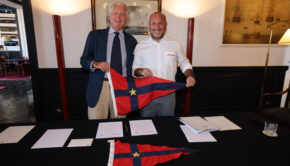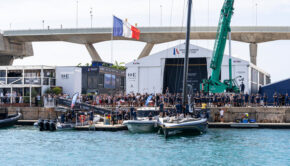Loss of Tradition and Audience
Published on June 4th, 2018
A lawyer by trade and Star boat sailor by passion, J. Joseph Bainton is wondering if the America’s Cup is evolving toward extinction. Here he observes.
While New York Yacht Club held the America’s Cup after World War II until 1983, it wisely had the presence of mind to have on board the Signal Boat a representative of a friendly “Challenger of Record” to challenge for the next Cup.
As a consequence, from 1958 through 1987, the Cup was sailed in 12 Metres by agreement between Defender and Challenger of Record. And while NYYC obviously did not begin the 1983 Cup expecting to lose, when it did, it had the good sense to immediately challenge by agreement again in 12 Metres.
For as long as I can remember, the Cup had vigorously contested Defender and Challenger Trials to select the two boats to ultimately sail in the Cup. Winning either trials was no mean feat. When the Cup went to Australia, the same high level of competition as among putative challengers and defenders continued. Then the Challenger won again, helmed by the Cup’s last loser, this time sailing for a different yacht club, San Diego Yacht Club.
But despite SDYC having good reason to believe it would win the Cup, for some reason it did not do what NYYC did for decades, namely have a friendly Challenger of Record in place to challenge immediately after the last race.
Instead, New Zealand’s Sir Michael Faye challenged in what became after vigorous litigation the first “Deed of Gift Challenge” in which Dennis Conner and his team showed Mr. Faye that he had not come close to designing the fastest boat fitting within the four corners of the Deed of Gift.
I was paid to observe the litigation and predict before the Court ruled whether there would be an America’s Cup in 1988. In that litigation, SDYC and Dennis fought hard to preserve tradition, pointing out, among other things, that Japan had just purchased 12 Metres and general public interest in the Cup had never been higher. However, SDYC lost and Dennis won the 1988 Cup in the first catamaran to race in it.
I often wonder what the Cup might be today if somebody from NYYC had thought to mention to the right person at SDYC that SDYC had best have a friendly Challenger of Record on hand when SDYC won the last race in Fremantle.
The Gold Cup in Bermuda is still being raced in IODs. The Congressional Cup is still being raced in Catalina 37s. If there had been half a dozen or so challengers and roughly the same number of defenders in trials leading to a Cup in 12 Metres in 1990 in San Diego, which was clearly the plan until Mr. Faye popped up, where would we be today?
Foiling is not everything. To many, it is not really sailing.
I do know for sure that during the 1970s and early 1980s, I enjoyed greatly sailing or motoring beyond Castle Hill and watching flights of putative challengers on one course and flights of putative defenders not far away on a different course compete day after day.
I enjoyed eating and drinking with members of some of the crews and listening to their war stories, because in those days there were so many sailors involved it was hard not to know some of them. But now all of this is gone in favor of a Cup with only three boats (foiling monohulls yet to be built) entered, including the Defender.
As a sailor, I would much prefer to see 10 to 18 well-crewed competitive 12 Metres showing up in New Zealand than three boats – no matter how fast or innovative they may prove to be. By comparison, can you imagine a Kentucky Derby with three horses entered? If anybody can market this three boat event, my hat is off to them.
I can understand why folks like Hap Fauth spend what it costs to be on top of the Mini Maxi Series and why Doug DeVos spends what it costs to be on top of the TP-52 Circuit. Those fleets have depth.
But I cannot help but wonder if Hap and Doug are having second thoughts about spending what they are going to have to spend to win a three boat race, as they are doing with American Magic, New York Yacht Club’s team that’s challenging for the 36th America’s Cup. Furthermore, I wonder whether doing so will prove to be the fun they originally thought it might be.
And finally, after this Cup, I wonder what level of interest there will be in having another one any time soon.
Key dates:
✔ September 28, 2017: 36th America’s Cup Protocol released
✔ November 30, 2017: AC75 Class concepts released to key stakeholders
✔ January 1, 2018: Entries for Challengers open
✔ March 31, 2018: AC75 Class Rule published
June 30, 2018: Entries for Challengers close
August 31, 2018: Location of the America’s Cup Match and The PRADA Cup confirmed
August 31, 2018: Specific race course area confirmed
December 31, 2018: Late entries deadline
March 31, 2019: Boat 1 can be launched
2nd half of 2019: 2 x America’s Cup World Series Preliminary Events
February 1, 2020: Boat 2 can be launched
During 2020: 3 x America’s Cup World Series Preliminary Events
December 10-20, 2020: America’s Cup Christmas Race
January and February 2021: The PRADA Cup Challenger Selection Series
March 2021: The America’s Cup Match
Protocol of the 36th America’s Cup
Key Points of the Protocol









 We’ll keep your information safe.
We’ll keep your information safe.